About 18 months ago, the Wireless Waffle team wrote a paper on the topic of what radio amateurs in the UK might have to pay if spectrum pricing was applied to the spectrum they use. The paper was offered to the RSGB and to Practical Wireless as material that could be used for an article in their prestigious magazines.
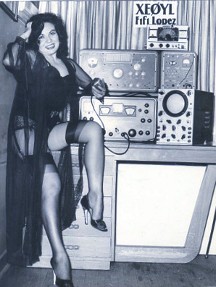 The RSGB indicated that it was not the sort of article they normally published as it didn't have antennas in it or any pictures of people standing on a mountain or remote desert island. Practical Wireless never responded as they were too busy assessing the merits of the latest amateur radio gizmo to come from Latin America (see right) and the whole thing got shoved to the bottom of the 'to do' pile and forgotten about. At least I think that was what the RSGB and PW said, the old memory is a bit hazy on the subject.
The RSGB indicated that it was not the sort of article they normally published as it didn't have antennas in it or any pictures of people standing on a mountain or remote desert island. Practical Wireless never responded as they were too busy assessing the merits of the latest amateur radio gizmo to come from Latin America (see right) and the whole thing got shoved to the bottom of the 'to do' pile and forgotten about. At least I think that was what the RSGB and PW said, the old memory is a bit hazy on the subject.
Whilst the material contained in the paper is now around a year old, it still makes for interesting reading and it is almost certain that Wireless Waffle readers will find it worth the time to study. Rather than think what to do with it next, it has been uploaded to the web-site and is now available for anyone to download and read.
So, for your reading pleasure, we present 'The Duffer's Guide to Spectrum Pricing. Pour yourself a beer, turn on your VHF radio, and have a read. Then, if you are a radio ham, realise how lucky you are to be able to afford that beer you just poured yourself!
 The RSGB indicated that it was not the sort of article they normally published as it didn't have antennas in it or any pictures of people standing on a mountain or remote desert island. Practical Wireless never responded as they were too busy assessing the merits of the latest amateur radio gizmo to come from Latin America (see right) and the whole thing got shoved to the bottom of the 'to do' pile and forgotten about. At least I think that was what the RSGB and PW said, the old memory is a bit hazy on the subject.
The RSGB indicated that it was not the sort of article they normally published as it didn't have antennas in it or any pictures of people standing on a mountain or remote desert island. Practical Wireless never responded as they were too busy assessing the merits of the latest amateur radio gizmo to come from Latin America (see right) and the whole thing got shoved to the bottom of the 'to do' pile and forgotten about. At least I think that was what the RSGB and PW said, the old memory is a bit hazy on the subject.Whilst the material contained in the paper is now around a year old, it still makes for interesting reading and it is almost certain that Wireless Waffle readers will find it worth the time to study. Rather than think what to do with it next, it has been uploaded to the web-site and is now available for anyone to download and read.
So, for your reading pleasure, we present 'The Duffer's Guide to Spectrum Pricing. Pour yourself a beer, turn on your VHF radio, and have a read. Then, if you are a radio ham, realise how lucky you are to be able to afford that beer you just poured yourself!
1 comment
( 1629 views )
| permalink
| 



 ( 3 / 45430 )
( 3 / 45430 )




 ( 3 / 45430 )
( 3 / 45430 )
Saturday 11 February, 2012, 12:52 - Amateur Radio, Electronics, Radio Randomness
Posted by Administrator
A while ago on Wireless Waffle, I commented on the daily loss of service that was occuring on my home broadband (ADSL) connection. It seems that this struck a chord with a number of people and remains one of the most commented-on articles on the site.Posted by Administrator
The question is, 'can anything be done to fix this problem'? The answer seems to be, that for a few pounds (a few and a bit Euros, or a few and a half Dollars) you can easily make a device which will provide additional filtering on your ADSL line and help with the problem of interference on the line. This solution is not a 100% guarantee of an improvement but does help and has resulted in an enormous (almost complete) reduction in drop-outs and, to boot, an increase in connection speed on the Wireless Waffle line!
The increase in broadband connection speed is perhaps an odd outcome but this is a result of a more stable connection on the line. This is why... The equipment at the exchange sets a target 'signal to noise (s/n) threshold' for each line depending on how reliable the line is. If the line continually drops out, the target s/n is increased to provide an additional 'safety margin' to try and stop future drop outs. If the line remains stable for a while (typically a couple of weeks), the exchange notices the difference and will lower the target s/n threshold. Each change in threshold is typically 3dB (a doubling or halving of power) and results in an approximately 500 kBps change in line speed. The Wireless Waffle line was originally synchronised with an s/n threshold of 12dB and a speed of just over 2 Mbps. As a result of applying the solution about to be described below, over a month or so, the target s/n was reduced (by the exchange) to just 6dB and the connection speed is just over 3.5 Mbps! Even with only 6dB s/n the line has remained completely stable for over two months and has not dropped out again once.
So how does this miracle solution work. Well, the first step is to gather the teeth of some bats at full moon when wolves are howling. Add to this, three drops of lizard spittle and some onyx droppings. Only kidding! It's not magic it's just simple electronics!
The solution comprises two simple pieces:
- A common mode choke which serves to remove any non-common mode signals from the line
- A low pass filter to get rid of any noise on the line which is outside the range of the ADSL signals
The low pass filter just stops any signals arriving on the line which are not needed for ADSL from getting into your modem and causing havoc. This could be strong short or medium wave broadcast signals which appear after dark, or could be strong local transmissions from a nearby radio amateur. Three different filter designs are presented which have differing degrees of effectiveness and you can choose which is the best for your situation.
To make the Wireless Waffle Anti-Daily Service Loss (or WWADSL) device, you will need:
1. Two pieces of (single core) wire, around 30 cm long
2. A ferrite toroid (eg FT50-43)
3. Two capacitors (either 1nF or 470pF - see below)
4. Two inductors (either 3.3uH, 4.7uH or 6.8uH - see below)
5. Six pieces (three pairs) of 'chock block'
6. An old phone socket to ADSL modem lead
No soldering is required and all the parts are reasonably readily available.
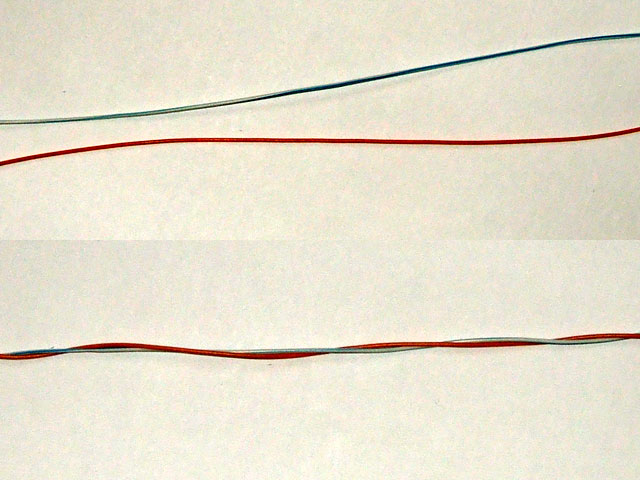 Let's start with the choke. This simply consists of two pieces of (single core) wire, twisted together and then threaded through a small ferrite toroid. The exact number of turns is not critical, but the type of toroid is important. You need a ferrite toroid which are usually black in colour, rather than any other sort which are distinguishable by the fact that they are generally painted a different colour (eg red or yellow). Ferrite toroids usually have names beginning 'FT', such as FT37-43 or FT50-43. The last number (eg 43) is the type of material which is the important bit. The first number is the diameter of the toroid in hundredths of an inch. The one used here is an FT50-43 which is about the right size. An FT37-43 is a bit small. Ferrite cores ending 43, 72 or 77 are ideal for this project.
Let's start with the choke. This simply consists of two pieces of (single core) wire, twisted together and then threaded through a small ferrite toroid. The exact number of turns is not critical, but the type of toroid is important. You need a ferrite toroid which are usually black in colour, rather than any other sort which are distinguishable by the fact that they are generally painted a different colour (eg red or yellow). Ferrite toroids usually have names beginning 'FT', such as FT37-43 or FT50-43. The last number (eg 43) is the type of material which is the important bit. The first number is the diameter of the toroid in hundredths of an inch. The one used here is an FT50-43 which is about the right size. An FT37-43 is a bit small. Ferrite cores ending 43, 72 or 77 are ideal for this project.Take the two pieces of wire and twist them together, all the way along their length. Wind these around the toroid to leave yourself with about 2 inches of wire (5 cm) free at each end. The result should look something like the pictures below.
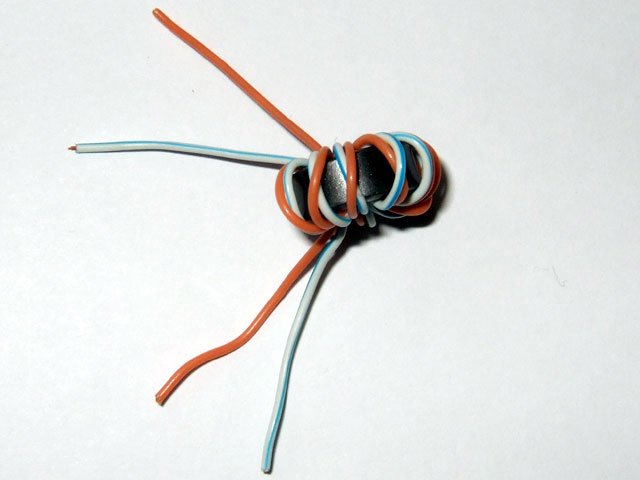
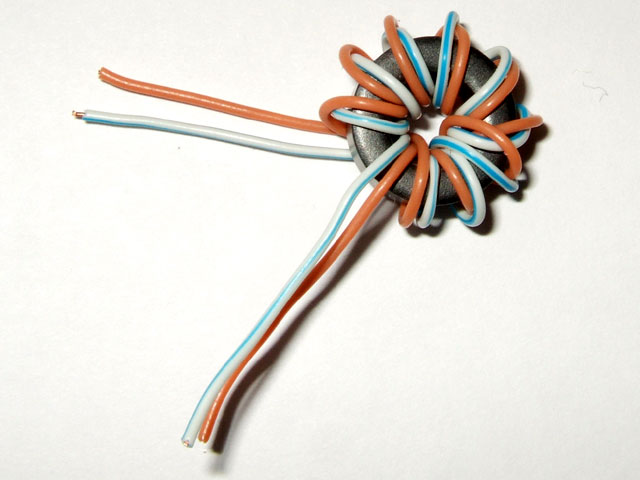
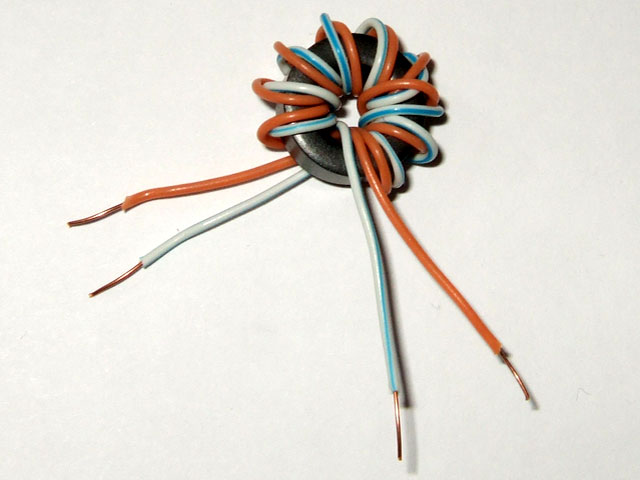
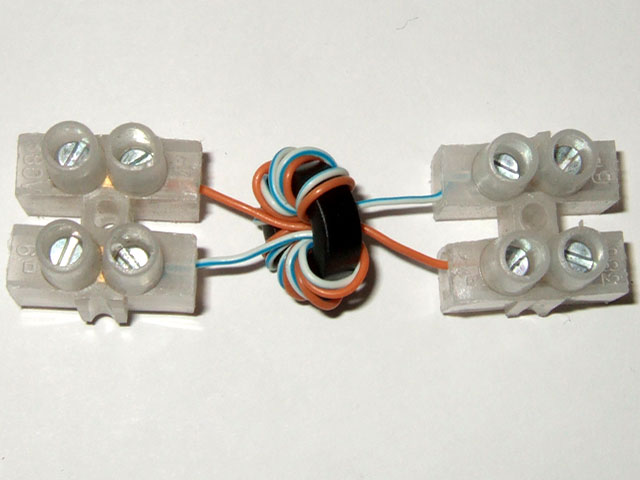 Connect one end of the wires into one side of a double piece of chock block, and the other into another.
Connect one end of the wires into one side of a double piece of chock block, and the other into another.Now you need to take a decision... If your line synchronises at over 4 Mbps, the chances are you might be using ADSL2+. ADSL2+ differs in that it uses frequencies on the telephone line up to 2.2 MHz, whereas ADSL and ADSL2 only use frequencies up to 1.1 MHz. There are three choices of filter:
- The 'mild' filter will allow all possible ADSL signals through including ADSL2+ and is suitable for all lines.
- The 'medium' filter will still allow ADSL2+ through but might cause some loss of connection speed (at the expense of greater reliability of course).
- The 'strong' filter will not allow ADSL2+ fully through as its frequency response begins to roll-off below 2 MHz and is therefore only suited if your line is running at speeds below 4 Mbps to start with.
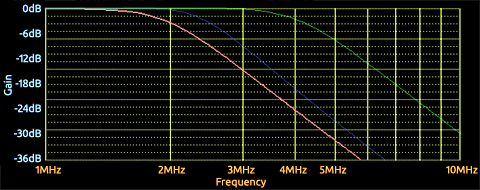
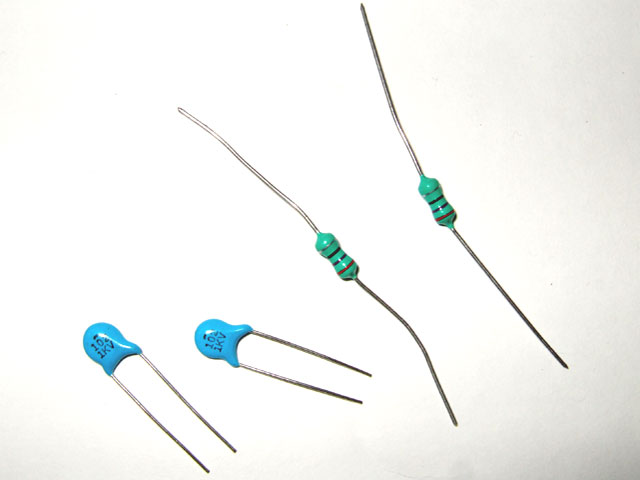 Each filter is made of two capacitors and two inductors. The table below shows which values you require, depending on your choice of filter.
Each filter is made of two capacitors and two inductors. The table below shows which values you require, depending on your choice of filter.| Filter | Capacitor | Inductor |
|---|---|---|
| mild | 470pF | 3.3uH |
| medium | 1nF | 4.7uH |
| strong | 1nF | 6.8uH |
Next take two of the inductors and a capacitor. On the opposite side of one of the chock blocks that has your choke connected, insert each of the inductors into one of the remaining holes and put the capacitor between the two holes. The other ends of the two inductors should now go into the final piece of chock block, and the remaining capacitor across the same chock block.
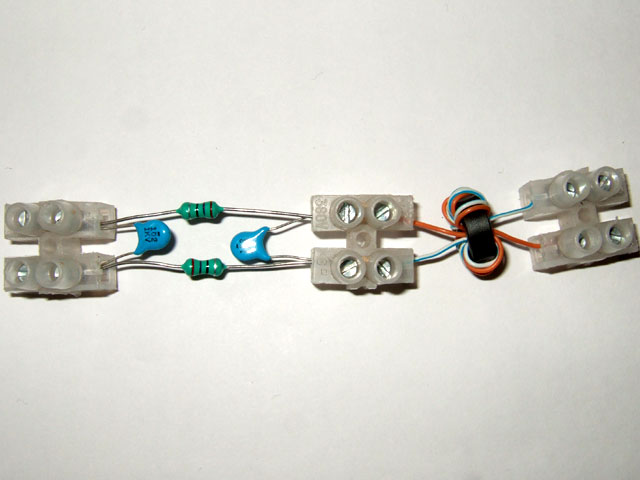 The results should look something like the picture on the right (if you haven't spotted it yet, you can click on the pictures to see a larger one).
The results should look something like the picture on the right (if you haven't spotted it yet, you can click on the pictures to see a larger one).Finally, take the 'phone socket to ADSL box lead' that you have and cut it about 30cm from the end which goes into the ADSL modem. Strip back the shielding on both pieces, which will reveal some wires. If you have two wires, no more action is taken. If you find you have four wires, identify which are the middle two and cut off the outer ones (these aren't used). In the wire shown below the red and green wires are the inner two and the black and yellow wires can be disguarded.
Take one piece of the cable and insert the two wires into one end of your chock block construction - it doesn't matter which end. Then do the same with the remaining piece of wire, at the other end of your construction.
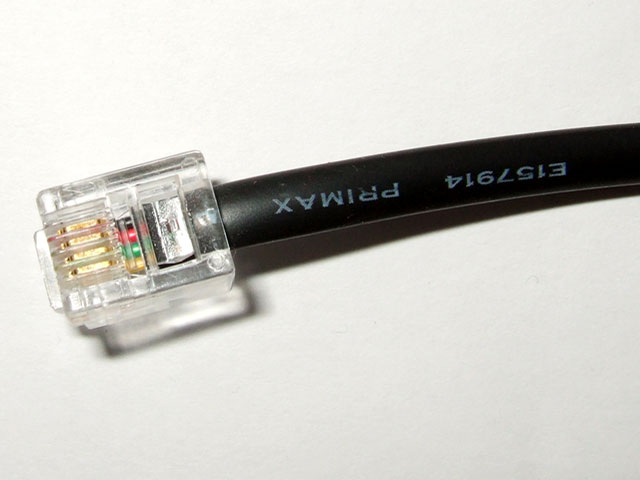
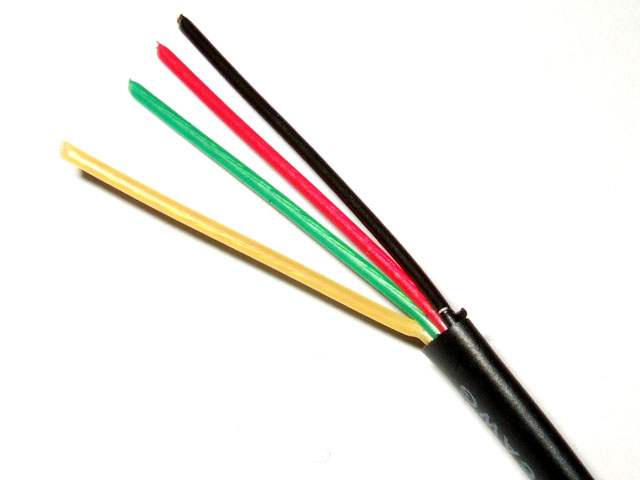
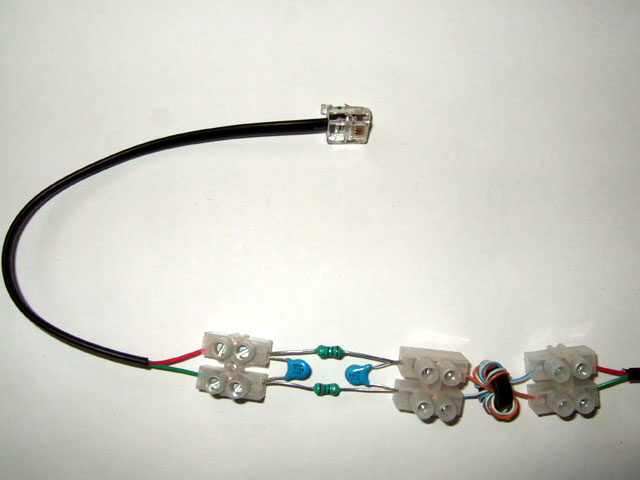
Bingo! You've finished. At this point it might be worth checking that there are no short-circuits. If you have a volt meter with a setting to measure resitance, check that:
- there is a connection between the two ends of the filter; and
- there are no short circuits across the chock blocks.
It's probably worth stating, just to be certain, that this is for ADSL connections (ie that which comes into your property on traditional copper telephone lines). It won't work with mobile broadband, cable broadband or satellite broadband!
Let us know how you get on and whether the WWADSL filter helps. Perhaps you might also like to share your construction experiences or tips with others too.
Wireless Waffle has talked extensively about pirate radio in the past, from short-wave music stations, to Brazilian sat-jackers. But it seems that, of all the nations on the planet, the Russians hold the baton for being the biggest pirates of them all.
This story begins when reading the latest intruder report from the IARU Region 1 Monitoring System. The report indicated that there had been an intrusion into the 80 metre amateur band between 3.5 and 3.6 MHz by Russian pirate stations running AM. Now historically the Voice of Korea (the North Korean broadcaster) has been transmitting in the 80 metre band (or the 75 metre band as it's called in in North America) on 3560 kHz in AM and the immediate assumption was that these new signals couldn't possibly be Russian pirates, but must be the Voice of Korea and perhaps a few other stations trying to jam it. The IARU report, however, says that the carriers are very unstable and that the modulation is voices in Russian.
 So the only thing to do to verify this story is to turn on a receiver and have a listen. Having done this, there were no obvious signals in the 80 metre amateur band. Having previous heard pirates just below the band at around 3450 kHz, the tuning dial was slowly rotated to ever lower frequencies. Nothing. And then, at 3175 kHz, something. A weak carrier... no, two carriers alternating... both rather unstable in frequency. Switching the receiver to AM yielded weak modulation. A bit more tuning, to 3125 kHz and a much stronger AM signal with a Russian voice and a wobbly carrier. Hey presto!
So the only thing to do to verify this story is to turn on a receiver and have a listen. Having done this, there were no obvious signals in the 80 metre amateur band. Having previous heard pirates just below the band at around 3450 kHz, the tuning dial was slowly rotated to ever lower frequencies. Nothing. And then, at 3175 kHz, something. A weak carrier... no, two carriers alternating... both rather unstable in frequency. Switching the receiver to AM yielded weak modulation. A bit more tuning, to 3125 kHz and a much stronger AM signal with a Russian voice and a wobbly carrier. Hey presto!
But what are these odd signals? Are they military operators in a private net (if so, why AM and why unencrypted)? Are they some kind of harmonics or intermodulation? Googling didn't bring much until a page on Sparky's Web Blog was found. It seems that these are effectively the equivalent of Russian CBers but presumably using much lower frequencies given the large distances between Russian cities. The band is known as the тройка band ('troika' in English which has several meanings from 'three of a kind' to a sledge or fairground ride). The band runs from approximately 2900 to 3200 kHz which are internationally allocated to the Aeronautical Mobile and Mobile services.
 There are aeronautical frequency assignments in the band (2872, 2899, 2921, 2962 and 3016 are frequencies assigned to North Atlantic traffic for example), but these lower frequencies are less often used unless propagation makes it totally necessary. Oddly, the various frequency lists for the band show very little aeronautical use in Russia (other than Irkutsk on 3016 kHz) - a coincidence? Probably the pirates know this and therefore feel free to mess about in the aviation bands, knowing that the Russian authorities are likely to be little interested in their activities.
There are aeronautical frequency assignments in the band (2872, 2899, 2921, 2962 and 3016 are frequencies assigned to North Atlantic traffic for example), but these lower frequencies are less often used unless propagation makes it totally necessary. Oddly, the various frequency lists for the band show very little aeronautical use in Russia (other than Irkutsk on 3016 kHz) - a coincidence? Probably the pirates know this and therefore feel free to mess about in the aviation bands, knowing that the Russian authorities are likely to be little interested in their activities.
If you're in Europe, when it gets dark (and lower frequency propagation opens up over the continent), why not give them a listen. It's fun to chase the carriers up and down in frequency. If you speak Russian, perhaps you could provide some translation as to what on earth they are talking about!
P.S. You might also want to take a listen to 2920 kHz USB as this seems to be a common calling channel for the more technically adept Russian pirates.
This story begins when reading the latest intruder report from the IARU Region 1 Monitoring System. The report indicated that there had been an intrusion into the 80 metre amateur band between 3.5 and 3.6 MHz by Russian pirate stations running AM. Now historically the Voice of Korea (the North Korean broadcaster) has been transmitting in the 80 metre band (or the 75 metre band as it's called in in North America) on 3560 kHz in AM and the immediate assumption was that these new signals couldn't possibly be Russian pirates, but must be the Voice of Korea and perhaps a few other stations trying to jam it. The IARU report, however, says that the carriers are very unstable and that the modulation is voices in Russian.
 So the only thing to do to verify this story is to turn on a receiver and have a listen. Having done this, there were no obvious signals in the 80 metre amateur band. Having previous heard pirates just below the band at around 3450 kHz, the tuning dial was slowly rotated to ever lower frequencies. Nothing. And then, at 3175 kHz, something. A weak carrier... no, two carriers alternating... both rather unstable in frequency. Switching the receiver to AM yielded weak modulation. A bit more tuning, to 3125 kHz and a much stronger AM signal with a Russian voice and a wobbly carrier. Hey presto!
So the only thing to do to verify this story is to turn on a receiver and have a listen. Having done this, there were no obvious signals in the 80 metre amateur band. Having previous heard pirates just below the band at around 3450 kHz, the tuning dial was slowly rotated to ever lower frequencies. Nothing. And then, at 3175 kHz, something. A weak carrier... no, two carriers alternating... both rather unstable in frequency. Switching the receiver to AM yielded weak modulation. A bit more tuning, to 3125 kHz and a much stronger AM signal with a Russian voice and a wobbly carrier. Hey presto!But what are these odd signals? Are they military operators in a private net (if so, why AM and why unencrypted)? Are they some kind of harmonics or intermodulation? Googling didn't bring much until a page on Sparky's Web Blog was found. It seems that these are effectively the equivalent of Russian CBers but presumably using much lower frequencies given the large distances between Russian cities. The band is known as the тройка band ('troika' in English which has several meanings from 'three of a kind' to a sledge or fairground ride). The band runs from approximately 2900 to 3200 kHz which are internationally allocated to the Aeronautical Mobile and Mobile services.
 There are aeronautical frequency assignments in the band (2872, 2899, 2921, 2962 and 3016 are frequencies assigned to North Atlantic traffic for example), but these lower frequencies are less often used unless propagation makes it totally necessary. Oddly, the various frequency lists for the band show very little aeronautical use in Russia (other than Irkutsk on 3016 kHz) - a coincidence? Probably the pirates know this and therefore feel free to mess about in the aviation bands, knowing that the Russian authorities are likely to be little interested in their activities.
There are aeronautical frequency assignments in the band (2872, 2899, 2921, 2962 and 3016 are frequencies assigned to North Atlantic traffic for example), but these lower frequencies are less often used unless propagation makes it totally necessary. Oddly, the various frequency lists for the band show very little aeronautical use in Russia (other than Irkutsk on 3016 kHz) - a coincidence? Probably the pirates know this and therefore feel free to mess about in the aviation bands, knowing that the Russian authorities are likely to be little interested in their activities.If you're in Europe, when it gets dark (and lower frequency propagation opens up over the continent), why not give them a listen. It's fun to chase the carriers up and down in frequency. If you speak Russian, perhaps you could provide some translation as to what on earth they are talking about!
P.S. You might also want to take a listen to 2920 kHz USB as this seems to be a common calling channel for the more technically adept Russian pirates.
Around the short-wave world, mention of 'PsyOps' has recently had reason to reappear. It refers to psychological warfare being conducted by NATO forces to 'scare' Colonel Gadaffi's forces into remission through a variety of activities. One of these activities is the broadcast of semi-threatening, warning messages to troops loyal to Libya's erstwhile leader.
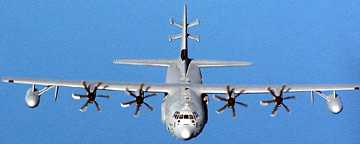 These messages have apparently been broadcast from a Lockheed Martin EC-130 aircraft known as Commander Solo overflying the region and are using the frequencies which belong to the 'Great Man Made River Authority' (GMMRA) which is Libya's authority responsible for artificially transporting water from wells in the Sahara desert via a big pipe to population centres in the North. Why NATO would have chosen these frequencies is not known, however there is (or was) apparently an ALE network on these channels that was presumably in regular use and hence there would be several receivers across the country in 'important offices' which would hear the PsyOps transmissions.
These messages have apparently been broadcast from a Lockheed Martin EC-130 aircraft known as Commander Solo overflying the region and are using the frequencies which belong to the 'Great Man Made River Authority' (GMMRA) which is Libya's authority responsible for artificially transporting water from wells in the Sahara desert via a big pipe to population centres in the North. Why NATO would have chosen these frequencies is not known, however there is (or was) apparently an ALE network on these channels that was presumably in regular use and hence there would be several receivers across the country in 'important offices' which would hear the PsyOps transmissions.
Frequencies reported in use by the GMMRA in recent times include 4200, 5037, 5047, 5300, 5368, 5768, 6884, 7000, 8161, 8200, 8800, 9218, 9250, 9375, 10125, 10375, 10404 and 11100 kHz. Previous reported frequencies also include 3000, 3900, 4050, 6800, 7805, 7900, 10215 and 10250 kHz (thanks to Btown Monitoring Post).
Of the above, NATO PsyOps transmissions have so far been heard on: 6877, 9376, 10125, 10404 kHz. Note that the 10125 kHz frequency is slap bang in the middle of the 30 metre amateur band but as this is a shared frequency with other services the transmission by the military does not contravene the ITU frequency allocation tables and is therefore, effectively legal. The use of 7000 kHz by the GMMRA is not, however, legal as this is an exclusive amateur allocation. Initially, many of the PsyOps transmissions were jammed (presumably by the Gadaffi regime) however they no longer appear to be so.
Here's the Wireless Waffle recording of Commander Solo on 10404 kHz made at 14:00 GMT on 12 July 2011. The transmission ceased at 14:20 GMT. The noise underneath the transmission also ceased around the same time, however whether the two are connected (ie the noise is an attempt at jamming) can not be confirmed. Given that this recording was made in the UK, it is clear that the power of the transmitter used by Commander Solo and his ilk must be reasonbly high. Judging by the signal strength and general propagation conditions at the time of the recording, a radiated power of at least 1 kiloWatt would seem about right. As normal HF aircraft radios have powers of at least 200 Watts, this seems quite feasible.
 Of course, all that the Colonel has to do to stop the NATO transmissions becoming a nuisance, is hand out free power line adaptors to at least one house on every street and all short-wave frequencies would be instantly jammed. Perhaps Colonel Gadaffi is an investor the Comtrend PLT devices that do all the damage and the reluctance of Ofcom to do anything about them is part of some previous UK-Libya trade agreement on arms sales. Surely now that the UK is part of a force against Gadaffi, Ofcom can now breach the terms of this agreement with the Libyan government to pollute short-wave and finally get rid of the menace of PLT?
Of course, all that the Colonel has to do to stop the NATO transmissions becoming a nuisance, is hand out free power line adaptors to at least one house on every street and all short-wave frequencies would be instantly jammed. Perhaps Colonel Gadaffi is an investor the Comtrend PLT devices that do all the damage and the reluctance of Ofcom to do anything about them is part of some previous UK-Libya trade agreement on arms sales. Surely now that the UK is part of a force against Gadaffi, Ofcom can now breach the terms of this agreement with the Libyan government to pollute short-wave and finally get rid of the menace of PLT?
 These messages have apparently been broadcast from a Lockheed Martin EC-130 aircraft known as Commander Solo overflying the region and are using the frequencies which belong to the 'Great Man Made River Authority' (GMMRA) which is Libya's authority responsible for artificially transporting water from wells in the Sahara desert via a big pipe to population centres in the North. Why NATO would have chosen these frequencies is not known, however there is (or was) apparently an ALE network on these channels that was presumably in regular use and hence there would be several receivers across the country in 'important offices' which would hear the PsyOps transmissions.
These messages have apparently been broadcast from a Lockheed Martin EC-130 aircraft known as Commander Solo overflying the region and are using the frequencies which belong to the 'Great Man Made River Authority' (GMMRA) which is Libya's authority responsible for artificially transporting water from wells in the Sahara desert via a big pipe to population centres in the North. Why NATO would have chosen these frequencies is not known, however there is (or was) apparently an ALE network on these channels that was presumably in regular use and hence there would be several receivers across the country in 'important offices' which would hear the PsyOps transmissions.Frequencies reported in use by the GMMRA in recent times include 4200, 5037, 5047, 5300, 5368, 5768, 6884, 7000, 8161, 8200, 8800, 9218, 9250, 9375, 10125, 10375, 10404 and 11100 kHz. Previous reported frequencies also include 3000, 3900, 4050, 6800, 7805, 7900, 10215 and 10250 kHz (thanks to Btown Monitoring Post).
Of the above, NATO PsyOps transmissions have so far been heard on: 6877, 9376, 10125, 10404 kHz. Note that the 10125 kHz frequency is slap bang in the middle of the 30 metre amateur band but as this is a shared frequency with other services the transmission by the military does not contravene the ITU frequency allocation tables and is therefore, effectively legal. The use of 7000 kHz by the GMMRA is not, however, legal as this is an exclusive amateur allocation. Initially, many of the PsyOps transmissions were jammed (presumably by the Gadaffi regime) however they no longer appear to be so.
Here's the Wireless Waffle recording of Commander Solo on 10404 kHz made at 14:00 GMT on 12 July 2011. The transmission ceased at 14:20 GMT. The noise underneath the transmission also ceased around the same time, however whether the two are connected (ie the noise is an attempt at jamming) can not be confirmed. Given that this recording was made in the UK, it is clear that the power of the transmitter used by Commander Solo and his ilk must be reasonbly high. Judging by the signal strength and general propagation conditions at the time of the recording, a radiated power of at least 1 kiloWatt would seem about right. As normal HF aircraft radios have powers of at least 200 Watts, this seems quite feasible.
 Of course, all that the Colonel has to do to stop the NATO transmissions becoming a nuisance, is hand out free power line adaptors to at least one house on every street and all short-wave frequencies would be instantly jammed. Perhaps Colonel Gadaffi is an investor the Comtrend PLT devices that do all the damage and the reluctance of Ofcom to do anything about them is part of some previous UK-Libya trade agreement on arms sales. Surely now that the UK is part of a force against Gadaffi, Ofcom can now breach the terms of this agreement with the Libyan government to pollute short-wave and finally get rid of the menace of PLT?
Of course, all that the Colonel has to do to stop the NATO transmissions becoming a nuisance, is hand out free power line adaptors to at least one house on every street and all short-wave frequencies would be instantly jammed. Perhaps Colonel Gadaffi is an investor the Comtrend PLT devices that do all the damage and the reluctance of Ofcom to do anything about them is part of some previous UK-Libya trade agreement on arms sales. Surely now that the UK is part of a force against Gadaffi, Ofcom can now breach the terms of this agreement with the Libyan government to pollute short-wave and finally get rid of the menace of PLT?

